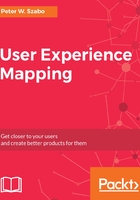
Kaizen-UX template
During the first few years of my consulting career, I have used the Three Rs template, with smaller or bigger modifications. The result of those learnings is the Kaizen-UX template.
So, our example will be as simple as I want to see the contents of my shopping cart. This is something a client would say to a developer, and that's the beauty of it.
Wait, did I just write a whole section, just to say write the output on a sticky note, and add anything else you see fit? Yes, and that's the most important learning from this chapter. People love templates, and user story templates are also attractive.
I'm applying the Kaizen continuous improvement principle to all areas of UX and life. We reached the above template by removing waste from a user story card template. The only thing that is surely not a waste is the output, the user story map is a structured collection of outputs.
Some projects may require personas (we will get there in the next chapter) or some other additions to this template, for instance, edge cases, acceptance criteria, or even actionable metrics (hopefully, you will never get there in the planning stage). Those can be added to the cards, and the project's template can and should be improved continuously.
What's more important is what gets into the template. So let's meet the INVEST rules.